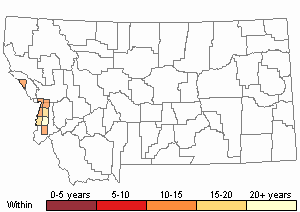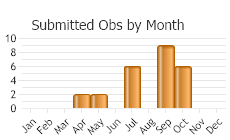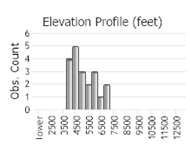View in other NatureServe Network Field Guides
NatureServe
Montana
Utah
Wyoming
Idaho
Wisconsin
British Columbia
South Carolina
Yukon
California
New York
Marbled Jumping-slug - Hemphillia danielsi
General Description
A moderately large slug of about 45 mm extended, but may reach 65 mm. As with all species of Hemphillia, the shell is partly exposed through a slit on the mantle about one-third its length, the mantle elevated into a visceral hump and covered with papillae. Dorsal base color is dark brown or dark gray, sometimes nearly uniformly so, and sometimes yellowish-gray to cream with numerous irregular dark markings; head coloration is dark brown or dark gray. The pneumostome is posterior to the midline of the mantle on the right side. The foot is narrow, with a median groove and tail pore near the posterior end, but lacking a dorsal keel. The sides of the foot with a uniform series of prominent oblique grooves, the sole is undivided (not tripartite); the mucous typically is clear. Sometimes responds to disturbance by thrashing the foot side to side and flipping themselves (Hendricks 2012, Burke 2013). Internal anatomy is described by Vanatta (1914) and Pilsbry (1948).
Diagnostic Characteristics
An elevated mantle in a hump, and presense of mid-dorsal mantle slit (sometimes exposing internal shell) separate the genus Hemphillia from other Montana slugs. Presence of small papillae on the mantle, a blackish to tan coloration, and a relatively narrow tail with poorly-defined or absent mid-dorsal stripe help differentialte this species from H. camelus.
Species Range
Montana Range
Range Descriptions

 Native
Native
Range Comments
Restricted to northwestern Montana west of the Continental Divide and adjacent northern Idaho (Burke 2013). In Montana, 24 records in three counties: Mineral (3), Missoula (1), Ravalli (20). Elevation range is 1157 to 2283 m (3795 to 7490 ft). The original description was based on specimens discovered in 1912 at several locations in the Bitterroot Mountains, Ravalli County (Hendricks 2012).
Observations in Montana Natural Heritage Program Database
Number of Observations: 25
(Click on the following maps and charts to see full sized version)
Map Help and Descriptions
Relative Density

Recency



 (Observations spanning multiple months or years are excluded from time charts)
(Observations spanning multiple months or years are excluded from time charts)
Migration
No information.
Habitat
Mostly in mesic mixed conifer forest, typically near water such as stream-side riparian areas and seeps. Canopy species include Engelmann spruce, subalpine fir, western redcedar, western hemlock, grand fir, Douglas-fir, alder, aspen, and black cottonwood. Usually found under woody debris and leaf litter or in downed rotten logs, sometimes under rocks (Hendricks 2012).
Food Habits
No information.
Ecology
It has been reported three times in the stomachs of terrestrial gartersnakes (Thamnophis elegans).
Reproductive Characteristics
Animals found in the wild as juveniles have lived more than 16 months in captivity.
Stewardship Responsibility
Threats or Limiting Factors
Habitat occupied by Hemphillia danielsi (moderate elevation mixed conifer forest, often near water) is threatened by logging, grazing, fire, and possibly weed control and rural home development. The impact of fire retardant on this and other terrestrial mollusks is not known. Little is known about this species, including its sensitivity to disturbance (Frest and Johannes 1995; Hendricks 2003).
References
- Literature Cited AboveLegend:
 View Online Publication
View Online Publication Frest, T.J. and E.J. Johannes. 1995. Interior Columbia Basin mollusk species of special concern. Final report to the Interior Columbia Basin Ecosystem Management Project, Walla Walla, WA. Contract #43-0E00-4-9112. 274 pp. plus appendices.
Frest, T.J. and E.J. Johannes. 1995. Interior Columbia Basin mollusk species of special concern. Final report to the Interior Columbia Basin Ecosystem Management Project, Walla Walla, WA. Contract #43-0E00-4-9112. 274 pp. plus appendices. Hendricks, P. 2003. Status and conservation management of terrestrial mollusks of special concern in Montana. Unpublished report prepared for the U.S. Forest Service. Montana Natural Heritage Program, Helena, Montana. 67 pp. + appendices.
Hendricks, P. 2003. Status and conservation management of terrestrial mollusks of special concern in Montana. Unpublished report prepared for the U.S. Forest Service. Montana Natural Heritage Program, Helena, Montana. 67 pp. + appendices. Hendricks, P. 2012. A Guide to the Land Snails and Slugs of Montana. A report to the U.S. Forest Service - Region 1. Montana Natural Heritage Program, Helena, MT. vii + 187 pp. plus appendices.
Hendricks, P. 2012. A Guide to the Land Snails and Slugs of Montana. A report to the U.S. Forest Service - Region 1. Montana Natural Heritage Program, Helena, MT. vii + 187 pp. plus appendices. Pilsbry, H.A. 1948. Land Mollusca of North America (north of Mexico), Volume II Part 2. The Academy of Natural Sciences of Philadelphia Monograph Number 2(2): 521-1113.
Pilsbry, H.A. 1948. Land Mollusca of North America (north of Mexico), Volume II Part 2. The Academy of Natural Sciences of Philadelphia Monograph Number 2(2): 521-1113. Vanatta, E.G. 1914. Montana shells. Proceedings of the Academy of Natural Sciences of Philadelphia 66:367-371.
Vanatta, E.G. 1914. Montana shells. Proceedings of the Academy of Natural Sciences of Philadelphia 66:367-371.
- Additional ReferencesLegend:
 View Online Publication
View Online Publication
Do you know of a citation we're missing? Hendricks, P. 2005. Surveys for animal species of concern in northwestern Montana. Unpublished report to the Montana Department of Fish, Wildlife & Parks, Montana Natural Heritage Program, Helena, Montana, May 2005. 53 p.
Hendricks, P. 2005. Surveys for animal species of concern in northwestern Montana. Unpublished report to the Montana Department of Fish, Wildlife & Parks, Montana Natural Heritage Program, Helena, Montana, May 2005. 53 p. Hendricks, P., B.A. Maxell, S. Lenard, and C. Currier. 2007. Land mollusk surveys on USFS Northern Region lands: 2006. A report to the USDA Forest Service, Northern Region. Montana Natural Heritage Program, Helena, Montana. 11 pp. plus appendices.
Hendricks, P., B.A. Maxell, S. Lenard, and C. Currier. 2007. Land mollusk surveys on USFS Northern Region lands: 2006. A report to the USDA Forest Service, Northern Region. Montana Natural Heritage Program, Helena, Montana. 11 pp. plus appendices. Hendricks, P., B.A. Maxell, S. Lenard, and C. Currier. 2008. Surveys and predicted distribution models for land mollusks on USFS Northern Region Lands: 2007. Report to the USDA Forest Service, Northern Region. Helena, MT: Montana Natural Heritage Program. 12 pp. + appendices.
Hendricks, P., B.A. Maxell, S. Lenard, and C. Currier. 2008. Surveys and predicted distribution models for land mollusks on USFS Northern Region Lands: 2007. Report to the USDA Forest Service, Northern Region. Helena, MT: Montana Natural Heritage Program. 12 pp. + appendices.
- Web Search Engines for Articles on "Marbled Jumping-slug"
- Additional Sources of Information Related to "Snails / Slugs"





